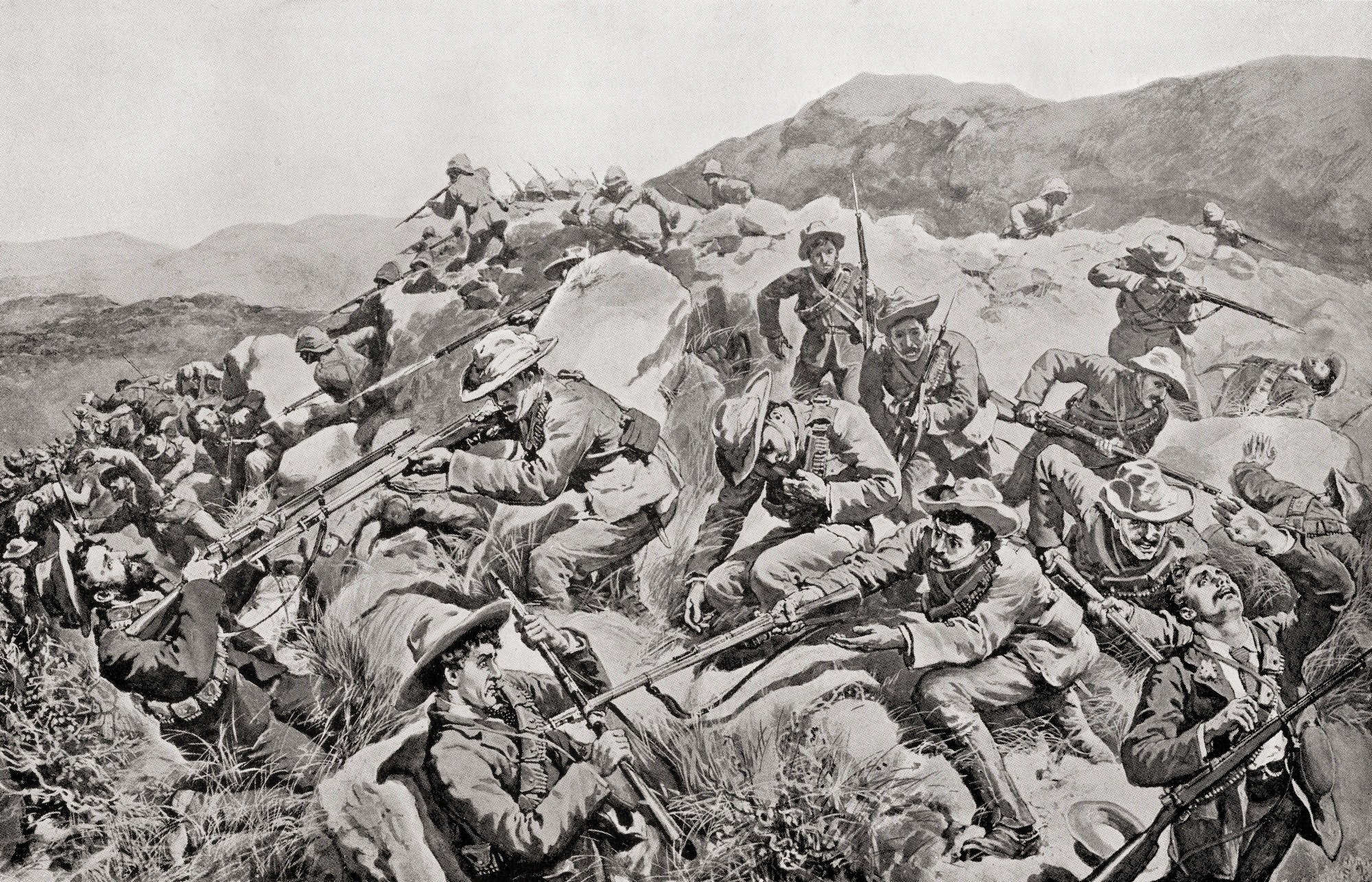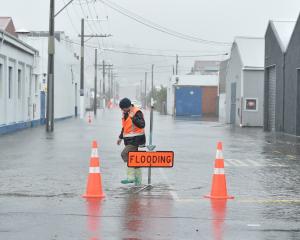
"Dunedin woke this morning to the bellowing of guns, the shriek of steam whistles, the mad clanging of bells," Otago Daily Times columnist Civis wrote on May 18, 1900.
"By the time we were dressed and out, the whole city was in a roar. Guns, bells, exploding fireworks; in the dim streets a rushing and shouting crowd.

That day, mirroring what was happening throughout the country, an estimated 35,000 Dunedin residents, 70% of the city’s population, gathered in the Octagon.
"As the morning advanced and the sun shone but benignly, Dunedin fairly abandoned itself to delirium. Processions, with every known musical instrument from a bass drum to a tea-tray, spontaneously formed, dissolved, reformed, drifted hither and thither," Civis wrote.
"From Hillside the railway workmen marched in, 200 strong, with banners and emblems - a ‘Long Tom’, Boer prisoners, a guillotine for [Transvaal president] Kruger. In the Octagon, poor Kruger was burned in effigy, his disreputable coat, rescued from the flames, left hanging from a lamp post."

As the country marks another Anzac Day, the Wellington historian says the impact of that war, although largely forgotten, was "profound and far reaching" and deserves to be remembered.
It was a war waged by the British Empire - the United Kingdom and soldiers from her colonies, including more than 6500 New Zealanders - against the two Boer Republics - the South African Republic (Transvaal) and Orange Free State.
The Boers were descendants of mid-17th century Dutch settlers and later French and German arrivals. The conflict was the culmination of a century of attempts by the British to annex and control the Boers, also known as Afrikaners.
The 217-day siege of Mafeking was one of several victories for Empire forces that, by the middle of 1900, saw most Boer towns and territories come under British control. Afrikaner kommandos then mounted a guerrilla war. The Empire initiated a scorched earth response - burning Boer farms, killing livestock and herding 150,000 Boer women and children, and then 115,000 native Africans, into the world’s first, large-scale concentration camps.
Living conditions in the hastily prepared camps were atrocious. Public pressure in Britain brought belated improvements, but about 50,000 people, many of them children, died in the camps.
By 1902, Afrikaner resistance had been crushed. A peace treaty was signed on May 31, giving amnesty to the Boers and control to the British.
Of the more than 6500 New Zealanders who took part in the war - from a total population of 800,000 - 182 died, including 86 of wounds and 74 of typhoid.
To the people living in New Zealand in the final year of the 19th century, the declaration of war was enormously significant, Robson says. The South African War would have an unalterable position as the country’s first foreign war and New Zealanders were, on the whole, enthusiastic supporters of it.

"During the war, newspapers were full of war coverage with a particular focus on the actions of New Zealand troops."
Wholesale support made the war a nationally unifying event that touched people’s purses as well as their pastimes.
Public fundraising paid most of the cost of sending the first two contingents of soldiers to South Africa.
Between 1898 and 1902, the number of Volunteer Corps and their members jumped from 13 corps with 808 members to 71 corps with almost 5500 members.
"At the time, few if any events united New Zealanders behind a common cause in the way the war did."
It also reinforced a sense of loyalty many felt to Queen and motherland, Robson says.
In September, 1899, New Zealand Prime Minister Richard Seddon told Parliament an "emergency" had arisen in South Africa that provided "the occasion ... for us to prove our devotion to the Empire".
"Two weeks later," Robson says, "Dunedin citizens perusing their Otago Daily Times learned that hostilities had commenced, in an article titled ‘War at Last’."
The impression the war made at the time is evident in the number of memorials to the Boer War (as it was called), and to the New Zealand soldiers who fought in it, that were publicly fund-raised and built throughout the country. About 50 were erected within six years of the war.
Public awareness of the war, however, inevitably diminished, Robson says.
"Especially as the First and Second World Wars eclipsed both New Zealand’s contribution to the South African War and the casualties the nation sustained.
"For years the sheer enormity of the two world wars has relegated the South African War to little more than a prelude to the main events."
Today, those memorials in towns and cities throughout the country are virtually the only concrete public reminders of the South African War. Even then, they are often misinterpreted as memorials to later wars, Robson adds.

The largest is the monument at the northern corner of Dunedin’s Oval.
In 1903, more than 10,000 people attended a fundraiser at Forbury Park that garnered £430, more than half the money needed to build the imposing memorial by Dunedin sculptor Carlo Bergamini.
Italian-born Bergamini designed and created the marble sculpture of a soldier, gun in hand, standing over a wounded comrade.
Robson’s awareness of the war in southern Africa came from a childhood fascination with war memorabilia, spurred by being made the young custodian of his grandfather’s service medals and other World War1 souvenirs.
"The oldest item in my collection came neither from France nor Egypt - it was a book on the Boer War published in 1900," he recalls.
"As a child I considered neither the accuracy of the images nor the book’s repeated references to the Boer War, a title that both downplayed British involvement and implied that the responsibility for the death and suffering that occurred lay solely with South Africa’s Boer population."
For his master’s degree topic, Robson chose New Zealand’s involvement in that war, but viewed from a new angle. His research, conducted while living in Korea in the early 2000s, with the help of images of hundreds of documents photographed in libraries while on trips back to New Zealand, formed the basis of a just-published book, Our First Foreign War: The impact of the South African War 1899-1902 on New Zealand.
"Until now, there has been no fine-grained analysis of the war’s impact on New Zealand society as a whole," he says.
His research uncovered a few surprises. Such as the burning of a mosque by soldiers, including New Zealanders, in a Malay settlement in the Cape Colony. Three soldiers, including a New Zealander, on a drunken spree in the Malay quarter tried to break into a house to escape an angry crowd of residents. The startled occupant killed one of the soldiers and seriously injured the other two, one of whom was a soldier from Dunedin. The home owner was later acquitted of wrong-doing, but not before 180 soldiers from the local army camp exacted revenge by burning down the Malay mosque.

"The involvement of New Zealand soldiers in the burning of a Malay mosque ... contrasts with New Zealand’s response to [March 15, 2019] events in Christchurch, yet few New Zealanders are even aware of it."
There are other clear differences between the New Zealand of the South African War period and now, he says.
The prevailing attitude to war is one. Despite a resurgence in numbers at Anzac Day services, based on a desire to honour past sacrifices, the widespread and largely unquestioning support New Zealand's involvement in the South African War enjoyed would be unlikely to occur in any modern conflict.
"While still criticised in some quarters, those that oppose New Zealand's involvement in foreign conflicts do not receive the same degree of public vilification they endured at the turn of last century."
Then, those who opposed the war - and there were some among politicians, church groups and unions - were openly ridiculed and ostracised.
A notable exception Robson uncovered was Charlotte Bewicke. Bewicke, who lived in Auckland, used her real name when defending the Boers in letters to newspapers and when raising money for sick and wounded Boers, all the while somehow avoiding public censure.
Attitudes to Maori have also progressed.
Those in command of the Empire forces in South Africa consistently declined offers of brown-skinned soldiers from the colonies. A common sentiment was that only white men should be allowed to fight other white men.
Maori politicians were among the first to support New Zealand’s involvement in the war and Prime Minister Seddon remained a vocal supporter of Maori involvement, Robson says.
"Although Maori were officially prevented from serving in South Africa, many Maori (perhaps 50 or 60) did serve, albeit under Pakeha names, some with distinction."
Today few people, if any, would question Maori involvement in the armed forces.
"As their long record of overseas military service shows - coupled with the number of Maori serving in the army, navy and air force - Maori form an integral and indivisible part of New Zealand's defence forces."

Among them were lessons learnt during the South African War that fed into roles New Zealand would play, and the way it would play those parts, in conflicts throughout the 20th century and in today’s peacekeeping.
That first overseas war proved New Zealand capable of providing soldiers who could perform well in a foreign field. It gave the country experience in quickly ramping-up production of war materials and in transporting animals, men and materials to overseas war zones. It gave New Zealand soldiers and officers experience fighting as part of a larger grouping.
"There have been very few major conflicts since then that we haven’t been involved in."
There are a few small signs that people are taking notice again of the South African War and its place in New Zealand’s story.
In Dunedin, for instance, in late-2018, South African War veterans’ graves and memorials in the Northern Cemetery were tidied and spruced up for the launch of a new Southern Heritage Trust cemetery trail, The Boer War Memorials Tour.
And last month, repairs began on the impressive Bergamini monument at the Oval. It is being cleaned and repointed by Dunedin City Council-contracted stonemasons, at a cost of about $20,000. The scaffolding is expected to be removed early next month, revealing again the New Zealand soldier in South African War uniform providing armed protection for his wounded and prone comrade.
This statue, still standing more than a century later, provides visual testimony to what Robson argues is another enduring legacy of the South African War - one more often associated with later theatres of war - the Anzac spirit of camaraderie.
"There were significant numbers of guys who served in New Zealand contingents who were actually Australians. There were New Zealanders in Australian contingents ... And there is evidence of New Zealand and Australian contingents fighting side by side in some of the most heated engagement in South Africa.
"I would argue the camaraderie that exists between New Zealand and Australian soldiers; there was evidence of that in South Africa more than a decade prior to Gallipoli."
• Our First Foreign War, by Nigel Robson, Massey University Press, April, 2021, $55 RRP












